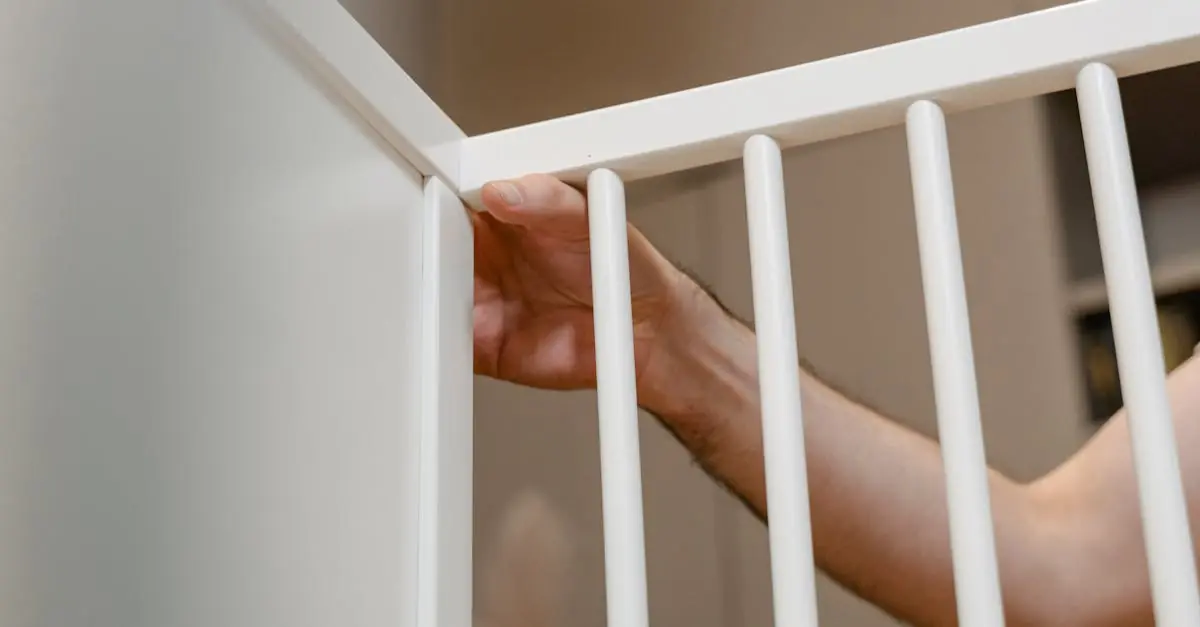Table of Contents
ToggleWhen it comes to little explorers, the world can be a dangerous place, and it’s up to parents to turn their homes into safe havens. Childproofing isn’t just about locking cabinets or covering sharp corners; it’s about outsmarting tiny adventurers armed with boundless curiosity. Think of it as a fun game of hide and seek, where the stakes are high and the players are short!
Every parent knows that a moment of distraction can lead to a mini disaster. By understanding the basics of childproofing, they can create a secure environment that allows their kids to roam free—without turning the living room into a miniature demolition site. So grab your safety gear and get ready to dive into the essential tips for transforming your home into a fortress of safety, all while keeping your sanity intact.
Understanding Childproofing Basics
Creating a safe space for children involves understanding childproofing fundamentals. These basics help parents provide a secure environment where kids can explore without constant worry.
Importance of Childproofing
Childproofing significantly reduces the likelihood of accidents. It protects children from household dangers and fosters a sense of independence. By taking preventive measures, caregivers can create an environment where children engage confidently with their surroundings. For instance, securing heavy furniture prevents tipping, while covering sockets minimizes electrical hazards. Establishing these safety protocols allows children to explore freely, ensuring their well-being.
Common Risks for Young Children
Understanding common risks helps parents identify potential hazards throughout the home. Small objects, such as coins or batteries, pose choking threats. Sharp corners on furniture can lead to serious injuries during playtime. Additionally, medications and cleaning supplies must remain out of reach to avoid poisoning incidents. Water-related risks, like drowning in bathtubs, require vigilant supervision. By recognizing these dangers, caregivers can implement effective childproofing strategies, promoting a safer living environment.
Room-by-Room Childproofing Strategies
Childproofing requires attention to detail in every room. Implementing strategies tailored to each space promotes safety for young children.
Living Room Safety Tips
In the living room, secure heavy furniture to walls using brackets. Store fragile items out of reach, opting for shatterproof materials when possible. Cover electrical outlets with childproof plugs to prevent curious fingers from accessing them. Keep cords from blinds and electronics out of reach, as they pose choking or strangulation hazards. Maintain a clutter-free environment to minimize tripping risks. Select soft, rounded furniture edges to reduce injury potential when children are playing.
Kitchen Precautions
The kitchen hosts myriad dangers, so it’s crucial to prioritize safety. Store knives and sharp utensils in locked drawers or high cabinets. Utilize stove guards to prevent burns or accidental cooking mishaps. Install safety latches on lower cabinets that hold cleaning supplies or hazardous materials. Keep small appliances unplugged and stored away to avoid accidental activation. Use non-slip mats to provide stability and reduce slipping incidents. Designate a safe play area away from the cooking zone to keep children at a safe distance.
Bathroom Safety Measures
In bathrooms, focus on preventing slip-and-fall accidents. Use non-slip mats in and around the tub or shower to ensure stability. Keep medications and personal care products stored in locked cabinets, as young explorers may mistake them for toys. Install faucet covers to avoid burns from hot water exposure. Adjust water heater settings to a maximum of 120°F to help prevent scalding. Always supervise young children during bath time to enhance safety and provide assistance when necessary.
Essential Childproofing Products
Childproofing products play a crucial role in enhancing the safety of homes with young children. These items help prevent accidents and allow kids to explore securely.
Safety Gates and Locks
Safety gates serve as barriers, keeping children away from hazardous areas such as staircases. Installations at both the top and bottom of stairs offer optimal protection. Locks on cabinets and drawers deter access to dangerous items, including sharp instruments and household chemicals. Magnetic locks provide additional security, requiring adult interaction for opening. Various styles fit different home designs, making childproofing both functional and aesthetically pleasing. Choosing the right safety gates and locks ensures a secure environment for little ones.
Corner Guards and Outlet Covers
Corner guards protect children from sharp edges on furniture such as tables and cabinets. Installing these padded guards minimizes the risk of injury during playtime. Outlet covers keep curious fingers away from electrical sockets, significantly reducing shock risks. Various designs are available, including sliding and plug-in options. Getting creative with colors and shapes engages children while keeping them safe. Utilizing corner guards and outlet covers contributes to a secure and child-friendly living space.
Maintaining a Safe Environment
Creating a safe environment involves ongoing vigilance and active participation from all family members. Regular evaluation of the child’s surroundings contributes to overall safety.
Regular Safety Checks
Routine inspections of the home identify potential hazards. Check for loose cords, unsecured furniture, and small objects within reach of children. Each room presents unique risks that require regular attention. Look for changes in storage, such as toys or household items that may become accessible. Adjustments in placements ensure that safety remains a priority as children grow. Performing these checks monthly helps maintain a secure environment and reduces the likelihood of accidents.
Educating Family Members
Family education plays a vital role in childproofing effectiveness. Informing adults about safety measures fosters a unified approach to child safety. Discuss the importance of supervising children during play and understanding childproofing devices. Encourage everyone to recognize and respond to hazards, like opened cabinets or misplaced medications. Share safety tips regularly to keep everyone engaged and vigilant. Engaging all family members creates a supportive atmosphere and enhances the overall safety of the home.
Creating a safe home for children requires a thoughtful approach to childproofing. By understanding potential hazards and implementing tailored safety measures, parents can foster an environment where kids can explore freely. Regular safety checks and family involvement are essential in maintaining these protective measures as children grow and their needs change. Investing time and effort into childproofing not only protects little ones from accidents but also promotes their independence and confidence. With the right strategies in place, parents can enjoy peace of mind while their children engage with their surroundings.





